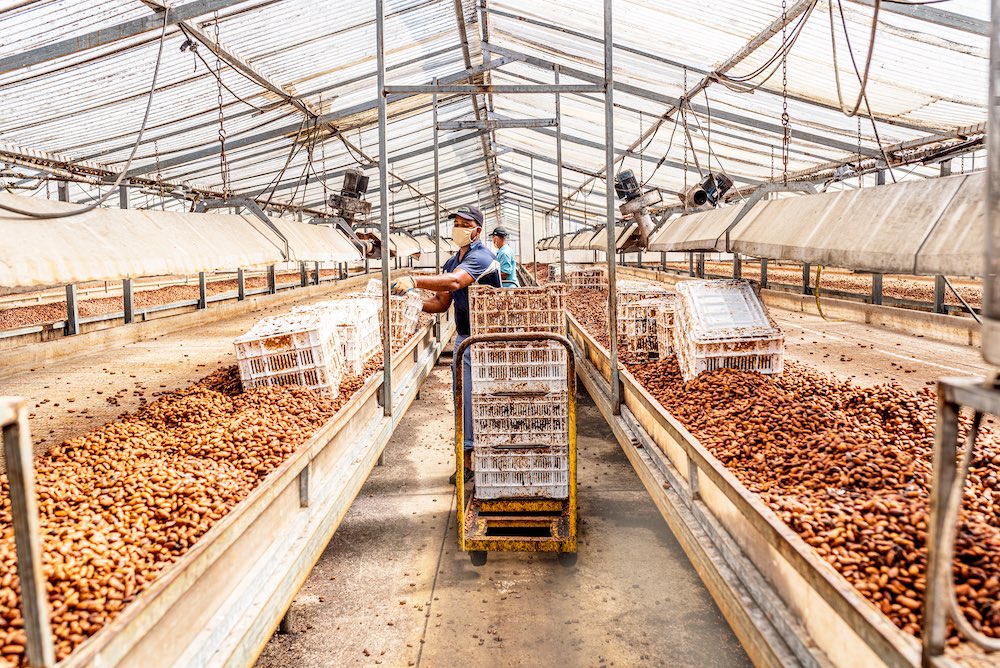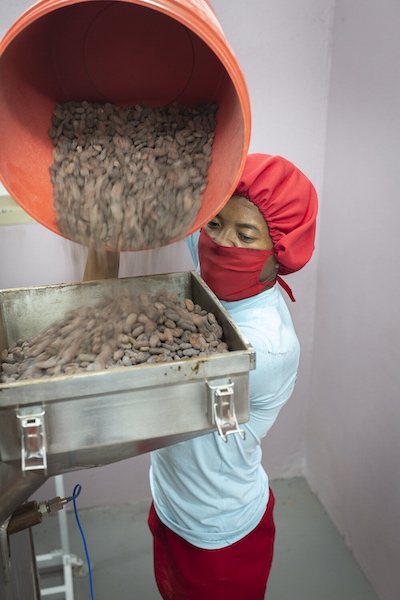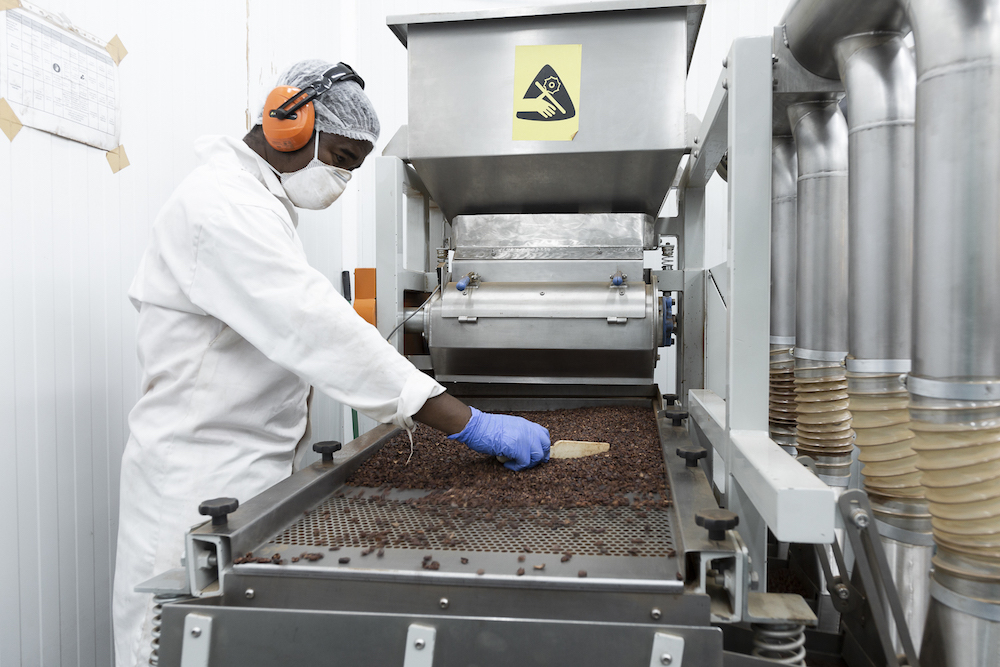As the pandemic disrupts daily life across the globe, food-related industries have been uniquely impacted, forcing adaptations of the kind we see today in the halls at ICE – strict screening, sanitary and personal protection protocols, and a reduction of the in-person educational experiences we are known for. For many months the machines in ICE’s bean-to-bar chocolate lab have lain idle, but the cacao and chocolate industry as a whole continues to operate, navigating challenges that affect every link in the supply chain.
I have been tracking some of these developments and the varied responses since the outset of the pandemic, and this week I reached out to several colleagues to assess their individual perspectives on this evolving situation.
Awareness of the seriousness of COVID-19 began to percolate early in 2020, but for much of the world realization of the true scale of spread accelerated quickly. As Sam Ratto of Videri Chocolate in Raleigh, North Carolina, describes the new normal of his day-to-day operation, “There is nothing that was the same as from Monday, March 16.”
Out front very early with a finger on the pulse of the chocolate industry was the Fine Cacao and Chocolate Institute (FCCI), surveying responses from the farm level to chocolate makers and pastry chefs. Executive Director Carla D. Martin, Ph.D., and partners on the ground at origin quickly determined several immediate fears of decreased sales, loss of cash flow, well-being of the workforce, and disruptions all along the supply chain forced by global travel restrictions and lockdowns. Similar concerns among artisan chocolate makers forced businesses to adapt their offerings, sales streams and customer engagement on the fly in the wake of sudden closures and shifts in consumer behavior. The hospitality industry, especially hotels and fine dining, remains in a state of limbo, likely the last to fully rebound.

Also providing early field reports were Heirloom Cacao Preservation (HCP) and specialty supplier Uncommon Cacao. Notable is the range in pandemic responses that vary by country but also the degree of their impact among rural cacao farming communities and larger towns and cities. “It hasn’t changed our basic operations,” says James Carouba, owner of HCP designee Terciopelo Cacao in Costa Rica. “Our workers are happy and relieved to have a job and don’t feel a lot of anxiety about COVID-19 out here in the country with extremely low population density.”
“Since most of our partner farmers are smallholders, there is not really a choice to not go out and farm — if they aren't able to grow the food they eat, they go hungry,” agrees Simran Bindra, co-director of Kokoa Kamili in Tanzania. “Farm labor tends to be carried out by the household (and obviously is outdoors), so there appears to not have been widespread transmission in the rural area that we're based in.”
Some countries limited travel internally. “Migrant farm workers are having a hard time getting into different districts in Guatemala because of restrictions,” says Sam, reducing crucial workforce needed at harvest. Others imposed curfews, like those still in effect in the Dominican Republic, which strain important family and social networks, yet Max Wax and Daisy Polanco of Rizek Cacao (and their Brooklyn facility, Kahkow) report that public response among their partners has remained calm and disciplined. Managing director at Ingemann in Nicargua, Lars Saquero Møller pulls back to provide a wider view there, where contentious politics have complicated the pandemic response and says, “the general fiscal situation in the country is deteriorating.”

Madagascar, an island known almost exclusively as a fine-flavor origin, has been officially closed to any international travel since mid-March. This has complicated the ability of Beyond Good (formerly known as Madecasse) to move key team members between headquarters in Brooklyn, factory operations near the city of Antananarivo, and other parts of Africa. Yet the proximity to their farming partners in the Sambirano Valley have proved to be an important benefit. “Our farmers took actions on the farms like many people, socially distancing, wearing masks, increased hand-washing and temperature taking. If anyone became sick, even with a sneeze, they stayed home. Our farmers are very much a part of our family. Thus far, life hasn’t changed much more for them than anyone else around the world, primarily because we can purchase their cacao and deliver it to our chocolate factory, located just down the road,” says Beyond Good Global Supply Chain Director Nate Engle. However, back in the Dominican Republic, Max told me that a portion of the most recent cacao harvest was lost simply due to delays in transporting cacao to their processing facility, deteriorating in transit. In many origins, a new harvest is currently underway. Uncommon Cacao’s partners in the Colombian regions of Sierra Nevada and Tumaco found innovative means of transporting beans earlier in the year and with recently lifted quarantines are confident in a productive season.
Likewise, reports from farmer-owned cooperative ABOCFA in Ghana are optimistic due to low risk of virus spread outside the main cities and the recent government-level adoption of a Living Income Differential that increase farmer wages. While it is encouraging that transmission among rural communities remains low, it is important to point out that lack of resources and access to medical care still place farmers in a precarious position.
The sector that appears hardest hit is the international shipping network at some origins, though some more than others. “We do a small amount of air freight each year, and the reduction in air traffic has severely increased the cost of cargo — we have received quotes as much as three times the normal rates. Even simple things like couriering shipping documents or samples have faced increased costs and massive delays,” says Simran at Kokoa Kamili.
For chocolate makers who source directly from origin, like Toronto’s SOMA, challenges will extend into the future. Owners David Castellan and Cynthia Leung say, “Shipping from origin, which we do occasionally, would be more difficult now. We were working on something from Nicaragua in the summer but there were no flights going at all from Managua. We couldn't get that shipment out... This issue will play out a bit more in 2021.” Like SOMA, most chocolate makers are currently sourcing beans from inventory already in warehouses prior to the pandemic. Sam considers himself lucky that, so far, he has only needed to allow a bit of extra time and planning when sourcing beans for Videri. The question is whether near-term supply remains stable as stocks are replenished while demand likely grows with an eventual ease in restrictions.
Everyone I spoke with, at all levels of the cacao supply chain, has emphasized the importance of protecting their teams and communities from the spread of COVID-19. Even though many observe that transmission has been minimal among rural farmers, mitigation measures and distributing personal protection remains a priority. “We put in a lot of safety measures at our facility to reduce the risk of transmission, including contactless purchasing from farmers, installing hands-free washing stations, and making sure we keep as many activities socially distanced as possible,” says Simran of Kokoa Kamili. “Additionally, we donated cleaning supplies and PPE to the local clinic.” When the Antananarivo public transportation system was closed in Madagascar, Beyond Good provided safe private transportation for factory staff. At Rizek’s central fermentation and drying facility in the Dominican Republic, worker shifts have been adjusted to allow for maximum distancing, and no visitors are allowed; normally, chocolate makers and researchers from around the world would visit nearly every day.

Perhaps most visibly striking have been the changes necessary on the retail level. At SOMA, the soul of the business was the in-person experience. “Our stores have drastically reduced staff, lots of barriers, PPE and COVID-19 procedures. Customers are limited, and it is basically in and out,” David says. “This is hard, as we always built our retails spaces for people to linger and to enjoy watching the process.” They, like others, realized the need to engage their customers in other ways. “Consumers have definitely drifted online for a lot of things. We still have retail stores open so they have the option, but people are scared and not really going out to a store unless it is necessary.” For a larger producer like Beyond Good, whose retail footprint extends to specialty and grocery stores across the country, “We’ve definitely experienced an uptick in online sales,” Nate says. “At the start of the pandemic, we were ‘bought out’ of many shelves around the country and for a short while, there was a bottleneck in the transportation/delivery system that limited restocking ability because of limited delivery truck space. That was an unforeseen situation, frankly, and it was not unique to chocolate nor to our business.”
But Simran is impressed with the resiliency of the fine chocolate market. “So many of our customers have pivoted to online sales, delivery, etc. The shift to new distribution channels has opened up new avenues of sales for a lot of our customers and we're happy to see how many of them are making it through this successfully.”
Meet ICE alumni working in chocolate.
Nestled in New York’s Hudson Valley, chocolate maker Fruition has had to consolidate, but on a recent visit to their factory, I got a sense of strong support from the local community. Co-owner Dahlia Graham tells me, “We opted to close our retail boutique in the town of Woodstock and to pivot our retail tasting room at our factory site in Shokan to a to-go window service only operation. We stopped offering onsite tasting samples. We have always been very big on keeping our facility clean but went ahead and installed better air filters and have increased sanitizing procedures and implementation of logs. We run daily staff temperature checks and wear masks. We also stagger arrival times and breaks among staff.” Early in the pandemic, specialty cacao bean suppliers worked to support chocolate makers in the short term with waived minimums, expanded credit terms, consignment deals and other incentives to cushion some of the initial shock. At the end of the day, for many chocolate businesses, it has been a real-time crash course in crisis management. “When I make it through the pandemic, I will have learned a greater level of patience, business savvy and overall grit I never knew I had,” Sam says.
As coronavirus cases here and abroad continue to surge with the fall and winter months, it seems inconceivable to consider silver linings just yet. But are there positive aspects to the shared experience of the past year? Having spent nearly two decades working in Africa, Nate sees this period as perhaps an opportunity to emerge stronger, smarter. “I’ve heard a lot of local expressions over the years,” he says. “One that always stuck with me was offered up by a Nigerian acquaintance who told me, ‘Never let a crisis go to waste.’ At first, I laughed, but the more I thought about it over the years, there is some wisdom in that statement. There are a lot negative, short-term things happening to a lot of people. I’m confident humanity will adjust and come out on top, though not without pain for many people.” Martin of FCCI emphasizes the power of community. “We certainly cannot underestimate how very serious the situation is and for how long we are likely to see the impact, but I still find rays of hope,” she says. “In particular, I see a focus on collaboration, attention to the need for social cohesion, and an openness to doing things in community that has been heightened by the difficult circumstances that we all face. This is true across the board — in cacao production as much as it is in chocolate production and sales — and bodes well for future prospects.”
Carla’s notion of community empowerment is a sentiment shared by many I speak to. We’ve all become accustomed to interacting through computer screens for business meetings, virtual classrooms and family gatherings. In recent months, the chocolate world has seized on this technology as a means of dialog and exchange of ideas. Almost daily, my inbox lights up with chocolate-related podcasts, webinars, panel discussions, classes and virtual tastings conducted through Zoom and other streaming and social media platforms.
Early in the pandemic, a virtual weekend-long chocolate festival paired enthusiasts around the world with dozens of chocolate makers under the Instagram handle @stayhomewithchocolate. Building on the early summer protest movements, Megan Giller organized a series of frank, honest conversations on the intersection of chocolate and issues of race and inclusivity. Weekly and monthly classes and discussions continue from a range of organizations, including FCCI, the Fine Chocolate Industry Association (FCIA), the Professional Manufacturing Confectioner’s Association (PMCA), and others. The result has meant more (and more accessible) opportunities for education and networking. Max and the team at Rizek are inspired by the connectedness after recently welcoming almost 400 virtual visitors to a live tour of the post-harvest facility. And by drawing more people into fine chocolate, this enthusiasm may be bringing more chocolate into the home. While many of us explored sourdough starters or jumped on the short-lived banana bread craze during the early days of quarantines, I couldn’t help but think at least a few amateur at-home chocolate makers emerged as well. Emily Stone, co-founder and CEO of Uncommon Cacao, confirms: “Yes, definitely! We've seen our sample sales, as well as our single bag sales, grow quite a bit this year.”
If you are a chocolate maker or pastry chef, you are encouraged to participate in the latest update to the FCCI survey, here. As we settle back into the Chocolate Lab at ICE, and until we can welcome students back for in-person bean-to-bar classes, I’ll be thinking of new ways to share our knowledge. Follow along @iceculinary #ChocolateLab.
Explore chocolate making in ICE's bean-to-bar chocolate lab.




